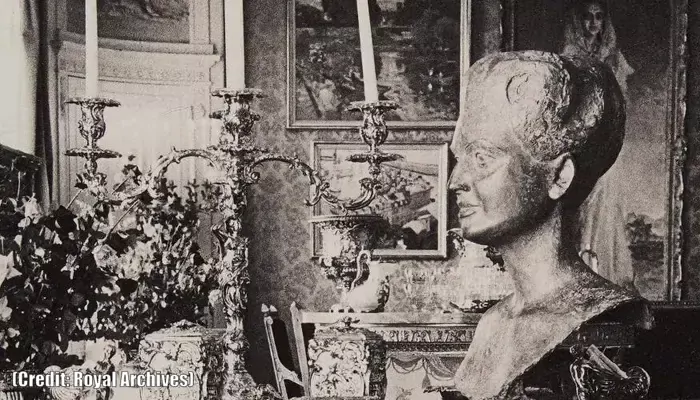
Read on, and you might feel like you're watching the plot of a Bollywood epic...only this was her real life.
Our society has always been patriarchal, and that shows in the way history is told. The spotlight is usually (almost always) on the kings. And even when a queen is mentioned, it’s mostly in relation to her husband, like who she married, how devoted she was, or what role she played beside the throne. Rarely do we hear about a queen who lived life on her own terms, who made headlines not because of the man she married, but because of the choices she made. Sita Devi, the Maharani of Baroda, was one of them. She was a woman of boldness and unbelievable glamor, so much so that her story could easily outshine many kings. She wore emeralds the size of pebbles, collected art like it was second nature, and lived a life that felt more like a movie than reality. And yet, we forgot her. Maybe because she wasn’t the kind of queen history was ready to remember.
So in this article, we’re bringing Sita Devi back into the spotlight, where she truly belongs.
Born on May 12, 1917, in Madras (now Chennai), Sita Devi belonged to the aristocratic family of the Maharaja of Pithapuram, Sri Raja Rao Venkata Kumara Mahipati Surya Rau.
Sita grew up in a world of refinement, with stately homes, handwoven silks, and classical education. But even as a child, it was clear she wasn’t going to be just another royal daughter blending into palace walls. She had a magnetic presence, and more importantly, the confidence of someone who knew her life would not follow the rules, but rather create them.
At 18, she married Meka Rangaiah Appa Rao Bahadur, the Zamindar of Vuyyuru, and had a son, Viduth Kumar. But the conventional life of a zamindarni naturally didn’t suit her. She wanted more. And she was about to claim it.
In 1943, at the Madras horse races, she met Maharaja Pratap Singh Gaekwad of Baroda, the ninth-richest man in the world at the time. Their attraction was instant and mutual, but there was one problem: she was already married.
Well, in a controversial move, Sita Devi converted to Islam to legally dissolve her marriage (divorce being next to impossible under Hindu law then), and later reconverted to Hinduism before marrying the Maharaja on December 31, 1943. The affair created a media frenzy, and Indian society was scandalized.
But she didn’t flinch.
Once married, Sita Devi’s taste for luxury knew no bounds. She had access to the Baroda treasury, home to one of the largest royal jewel collections in the world.
Among her most prized possessions were:
*The seven-strand Baroda Pearl Necklace, crafted from natural pearls of unmatched size and quality
*The Star of the South diamond (128.8 carats), set alongside the English Dresden diamond (78.5 carats)
*The Hindu Necklace, designed in 1950 by Van Cleef & Arpels; 13 Colombian emeralds totaling over 150 carats, shaped with a lotus motif
*She even commissioned quirky luxuries: gold tongue cleaners, custom ruby cigarette holders, and personalized vanity cases. The staff at Van Cleef fondly nicknamed her “Mrs. Brown” for her eccentricities and regular visits.
In one memorable incident, when Wallis Simpson (Duchess of Windsor) wore a Harry Winston necklace made from anklets that once belonged to Sita Devi, the Maharani said, “They looked better on my feet.”
After India’s independence, Pratap Singh’s mismanagement of state funds (including interest-free withdrawals from the Baroda treasury) drew the attention of the Indian government. In 1951, he was formally deposed by the Government of India.
But Sita Devi didn’t slow down.
She relocated to Europe (Monte Carlo, to be exact) and later Paris, where she set up a palace of her own, complete with Louis XVI furniture, and a fleet of custom cars. Her wardrobe reportedly included thousands of chiffon saris, each with matching accessories crafted by her personal atelier, Saree & Co.
She socialized with the elite: Aristotle Onassis, Grace Kelly, and even Gianni Agnelli. At the 1969 Ascot Gold Cup, she invited guests to rub her 30-carat sapphire for good luck.

While most know Sita Devi for her jewels, fewer realize she was also a serious art collector. Her homes were filled with both Indian miniatures and European masterpieces. Though specific works remain undocumented publicly, her Paris apartment reportedly housed pieces from French Impressionists and Rococo artists, reflecting her fusion of Indian sensibility and European taste.
She also supported bespoke craftsmanship, commissioning decor and objects that fused Mughal and European elements, acting as a bridge between cultures at a time when few Indian women were seen outside their domestic roles.
But the fairytale had cracks. Her marriage to Pratap Singh ended in divorce in 1956. He moved to London; she stayed in Paris.
Maintaining her lifestyle without royal backing became very difficult. So, she began selling her prized jewels. In 1974, some of her pieces went up for auction, though she never admitted the financial strain publicly.
The final blow came in 1985, when her beloved son Princie died by suicide at age 40. Plagued by depression and addiction, his death devastated her. She withdrew from society and was rarely seen in her final years.
Sita Devi died in 1989, in her Paris apartment, aged 71, far from the spotlight she once commanded.
She dared to be seen in a world that expected women like her to remain silent. And she rewrote her destiny with bold choices. Though history chose to turn the page on her too quickly, her legacy lives on, and how!